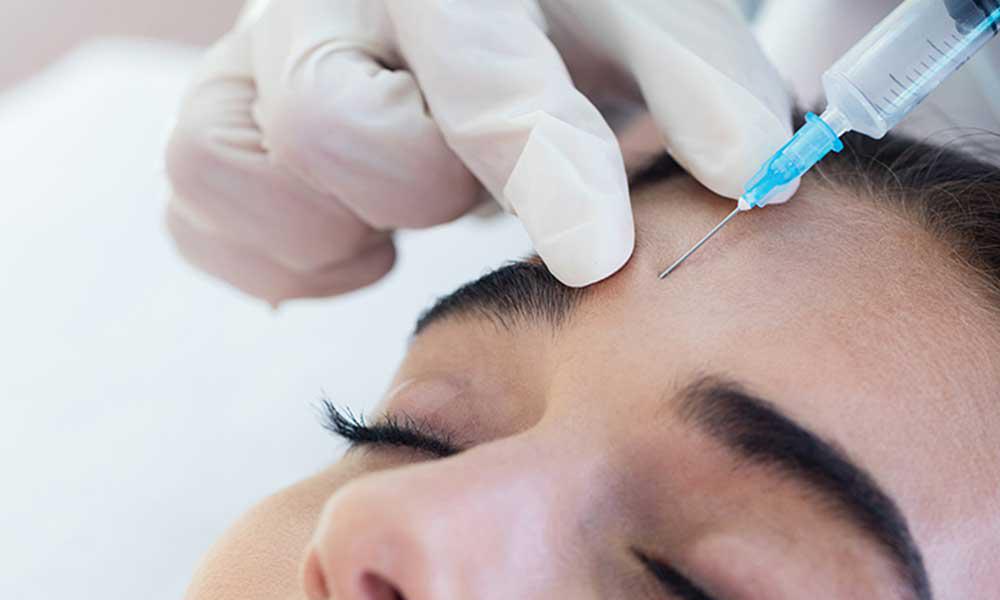Botox is one of the most popular cosmetic treatments in the field of aesthetics. When you decide to see a plastic surgeon for Botox injections, you are choosing an expertly trained, more reliable, and experienced medical professional who can safely treat common signs of aging without the risks.
As the leading minimally invasive cosmetic procedure, Botox is trusted by millions of patients to safely and effectively diminish wrinkles and fine lines, minimize aging in hands, and prevent future signs of aging from deepening. However, since 2000, there has been a 459% increase in Botox injections in the United States,[1] leading to a spike in the popularity of medspas. And, practitioners from a wide range of medical specialties have now also added an entire suite of Botox services to their practices. But, the training and certification for Botox may not be as comprehensive, formal, or as hands-on as the patient hopes.
In the past couple of years, Dr. Alyson Wells has seen a drastic increase in patients seeking correction to poorly performed Botox procedures. Possessing the necessary skills, knowledge, and experience at both her private practice and as an assistant professor at Johns Hopkins University, Dr. Wells understands the proper ways to approach Botox treatments – and unfortunately, the proper ways to improve other injector’s mistakes. If you would like to see how Dr. Wells can safely and effectively diminish common signs of aging from your appearance with Botox, please schedule a personal consultation at our Baltimore offices. To reach our front desk, please call (410) 628-8200.
About Botox
Botox is made of Botulinum toxin type A: a neurotoxin that has been utilized in dermatology and general medicine since 1989. Unlike dermal fillers, the Botox compound is injected intramuscularly instead of inside the dermis. Once inside the muscle tissue, Botulinum toxin type A diffuses into the neuromuscular junction where it attaches to the protein-membrane responsible for acetylcholine production.[2] Acetylcholine is a neurotransmitter that acts as a messenger between nerve cells and other neighboring tissue. When the acetylcholine production in this area is hindered, the brain can’t tell the muscle to contract or move. So, the muscle relaxes. The overlying wrinkles ease and smooth away their tension, causing them to disappear. Also, because the muscle cannot flex, future wrinkles can’t develop as long as Botulinum toxin type A is still present in the tissue, so benefits from Botox can last for months to come.
Botox Injector Training
Because of its effectiveness at achieving a younger appearance in patients, Botox has quickly become a household name and has earned its place in many well-trained aesthetic surgeons’ practices. However, due to the presumed ease of application, many different medical practices are introducing Botox injections to their clientele. This can include dentists, dermatologists, general practitioners, and medspas. And more often than not, it’s not the MD that’s performing the injections. While many patients can see remarkable results, other patients have seen adverse results that span from mild to serious – adverse side effects that could have been avoided if the initial treatment was performed safely and properly.
How To Become A Botox Injector
A quick Google search of “Botox Injector Training in Baltimore” yields 219,000 results. To put it lightly, there are a lot of Botox Injector Training programs available for aspiring injectors in the Baltimore area. Some of these programs are exceptionally informative and teach Botox injection techniques the correct way, but it is hard to tell which ones those are because of the sheer number of options available. Many advertise certification in as little as 8 hours in a virtual class. Others market that students receive “only one-hour training on a live model”. Many promote proper training in just one day. Students can take the class online and begin working on real patients the very next day, with little to no supervisor involvement from the course. Human anatomy is too complex for a one-day course. One day is too short to teach students everything they need to know about Botox injection. Though Botox injections appear simple, they cause serious side effects if performed by an inexperienced, ill-trained injector.
What Can Go Wrong
Botulinum toxin is safe for humans, and the compound’s potency makes it effective at erasing wrinkles. So, it needs to be handled and administered with expert care to prevent adverse reactions. After injection, the Botox serum can spread 30-45mm from the treated site and affect muscles separated by fasciae.[3] This can cause other neighboring muscles, not targeted for treatment, to go lax. Commonly, when treating the wrinkles around the orbital region of the skull, Botox serum can spread to the eyelid and cause eyelid ptosis: a condition where the eyelid droops and is unable to open or close. The Botox serum becomes transient after two to five days from injection and persists on average for three and a half weeks.
Other common side effects of poorly performed Botox injections are dysphonia, dysphagia, and dystonia. This can cause the patient to lose the ability to speak, swallow, and cause muscle spasms that can last for weeks on end. Patients report having serious difficulty eating which sometimes results in emergency room visits. Others report painful incessant muscle spasms that overtake their neck or face. When the neck muscles are treated to reduce the appearance of wrinkles and loose skin, the Botox serum can migrate into the wrong muscles.. In more serious cases, the patient needs to resort to a soft diet that can be easily swallowed.
Going To A Surgeon For Botox
Unlike the one-day special certification that is often the path to becoming a Botox injector, training in plastic surgery is longer, more arduous, and more substantive. The normal route to board certification in plastic surgery begins after four years of undergraduate study followed by four years of medical school. After medical school, a surgeon spends six years in residency and then another couple of years completing specialized training in fellowships. In all, a plastic surgeon requires around 15 years to become board certified. With their functional training and education in the complexities of the human musculoskeletal system as well as aesthetic surgery, plastic surgeons possess a unique skill set when it comes to cosmetic procedures. This is not an education that can be condensed into a virtual seminar “in as little as 8 hours!”
Personal Consultation
Dr. Alyson Wells, M.D., F.A.C.S. is a double board-certified plastic surgeon. Dr. Wells attended Washington University School of Medicine in St. Louis, one of the top five medical schools in the nation, where she graduated in the top 10% of her class. From there, her first internship and residency were at one of the highest-ranked American hospitals – The Johns Hopkins Hospital, Baltimore. During this time, she was named Outstanding Chief Resident in the Department of Head and Neck Surgery. After her residency at Johns Hopkins, she underwent a second residency in plastic and reconstructive surgery. As an expert in these two fields, Dr. Wells earned double-board certification in plastic surgery and otolaryngology – head and neck surgery. Now, along with her private practice, Dr. Wells serves as a teaching physician at Johns Hopkins Hospital and as Chief of Plastic Surgery at Greater Baltimore Medical Center.
Why Choose Dr. Wells For Botox
Unlike other medspas where other staff administer the Botox injections, Dr. Wells does all her patients’ injections herself. Here, she can take executive control over the patient’s experience and work to provide only beneficial results. With her extensive experience in both plastic surgery and head and neck surgery, Dr. Wells knows how best to treat these areas and how to avoid any future complications. Patients choose Dr. Wells because she is an expert in this field and consistently produces wonderful results for all of her clients.
Your Experience at Valley Plastic Surgery & MedSpa
Many patients schedule a consultation with Dr. Wells after experiencing adverse reactions to Botox treatments. There are ways to remedy a botched Botox injection, and Dr. Wells will explain how she’ll treat your unique circumstance during your consultation. If you’re a new patient you will have the opportunity to discuss your desired appearance and answer any questions you may have about Botox injections–or any of our other services. Your safety and satisfaction are paramount to Dr. Wells and her team, so she will go to every length to achieve your desired aesthetic safely.
How Much Does Botox Cost In Baltimore?
The cost of your Botox treatment will depend on the number of units used during your treatment. We will discuss and determine the cost of your treatment during your private consultation. If you have any questions about our prices, please don’t hesitate to call our friendly front desk at (410) 628-8200. Be sure to stay up-to-date on all things Valley Plastic Surgery and MedSpa by reading our blog and checking our current specials!
FAQ
What is Botox?
Botox is a popular cosmetic treatment to address wrinkles, fine lines, and other common signs of aging. It consists of Botulinum toxin type A, a neurotoxin that inhibits the treated muscle’s ability to contract. This causes any overlying wrinkles to smooth away and relax. Botox patients see a younger appearance for the next couple of months.
Is Botox safe?
When performed by an experienced and trained medical professional, yes Botox is safe. It has been used in medical operations since 1989 and has quickly become one of, if not the, most popular aesthetic procedure in the world.
References
- American Society of Plastic Surgeons. (2020). American Society of Plastic Surgeons. https://www.plasticsurgery.org/news/plastic-surgery-statistics
- Satriyasa B. K. (2019). Botulinum toxin (Botox) A for reducing the appearance of facial wrinkles: a literature review of clinical use and pharmacological aspect. Clinical, cosmetic and investigational dermatology, 12, 223–228. https://doi.org/10.2147/CCID.S202919
- Witmanowski, H., & Błochowiak, K. (2020). The whole truth about botulinum toxin – a review. Postepy dermatologii i alergologii, 37(6), 853–861. https://doi.org/10.5114/ada.2019.82795














